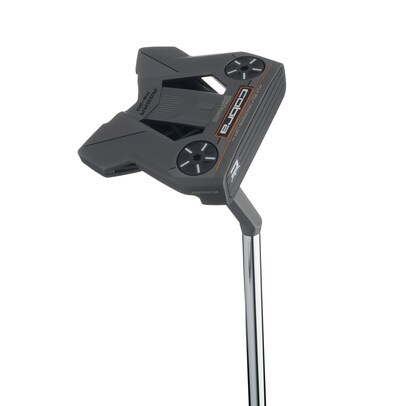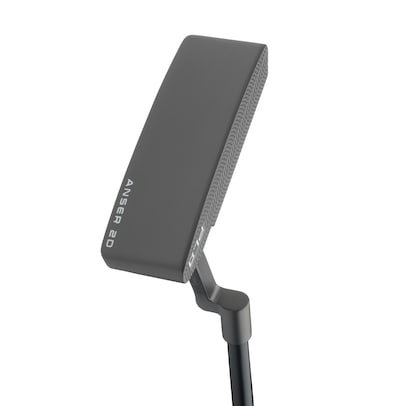Hot List
Best Putters: Performance
The best clubs in each category of the Hot List reflect excellence in an array of criteria, as judged by our player testing. For putters, it would seem like performance can easily be judged by a single metric: Did the ball go in the hole? To do so, however, would be folly. Yes, hearing the pleasing plunk when a putt drops is music to one’s ears, but things such as a green-hugging roll with minimal hop or a face-weighting combination that creates consistent distance control are valued as well. These individual lists provide a way to identify the performance within the category. Here you’ll see how 32 players evaluated putters (whether mallets or blades), based on each player's interpretation of the criterion of Performance, with each achieving a minimum of 4.5 stars from our players in that area.

The appeal of Bettinardi’s putter shaping is that the designs look like something from a simpler era. The company’s milling process, however, is built on a seamless blending of old-world vision and modern-day precision. The face’s flymill pattern creates a uniform feel, sound and control from heel to toe. The subtle sloping of the shoulders in the back flange frames a ball-width cavity and centers the putterhead’s mass to stabilize aim and stroke.

A certain juice company touts its beverages as “100 percent un-fooled around with.” In golf, that company could be called Simply Bettinardi. These unfooled-around with designs eschew face inserts and screw weights and are milled from a block of 303 stainless steel. The pocket cavity and flange shift the center of gravity in line with the center of the face for crisper contact. A uniform “flymilling” pattern on the face stretches from heel to toe for consistent sound, feel and energy transfer.

Designers of mallet putters can be guilty of over-engineering everything—from moment of inertia to center of gravity—and forget about how the face feels at impact. That’s why the Bettinardi team uses the tour-preferred 303 stainless steel from its blade putters in a single piece at the front of these four large mallets. A back piece of softer aluminum provides the stability and alignment features mallet users demand.

As any 6-year-old schooling us at Volcano Mini-Golf reminds us, putting is easy. Cobra knows better, and that’s why these putters are engineered to compensate for erratic strokes. Custom 3-D printed internal structures save mass that is used to monumentally increase stability on off-center hits for better distance control. The face has staggered lofts from top to bottom to ensure that wherever we make contact, our putts launch the same way. Take that, rug rat.

When Evnroll founder and longtime putter designer Guerin Rife first designed a putter with grooves, players consistently left putts short because the grooves softened the energy transfer at impact. Change the design of the grooves, he reasoned, and he could better control ball speed across the face. Rife continues to refine that idea on these classic blades with a soft aluminum face insert that produces consistent distance and direction.

The musical “Shrek” reminds us that we need to raise our freak flag high because, to paraphrase, weird for a purpose works. L.A.B. Golf’s putters are a good example in golf. Their distinctive looks belie a foundational idea that is irrefutable: If a putter’s weighting keeps it square to its lie angle (like this one does with its sole-weighted aluminum body), it’s going to square up. The company’s original Directed Force putter reveled in that idea, and this third generation continues in the same freakish but sleeker shape.

Golf seems smitten with milled putters as if they were some kind of farm-to-table quiche pan. Meridian takes your artisanal-cheese swooning and makes its finished tool more practical and technologically efficient. Rather than milling putters one at a time, a special process might cut a dozen or more blades out of that single block at once. Those blanks are then finished with another precise milling process that includes three face patterns for three different feels. All that mass customization takes these delightfully authentic blades to a place rarely seen in golf today: affordability.

As greens have gotten faster, and average putting strokes have gotten yippier, putterheads in response got heavier. When Mizuno’s team, which had offered a weight kit with its original M.Craft lineup, saw more users opt for the heaviest possible configuration of those weights, the OMOI was born. The stock heads are almost 20 grams heavier than some standard models, shifting the club’s balance point lower and leading to more consistency in face rotation. One other thing all yippy putters need is more forgiveness on off-center hits.

Most of us think of the putter face as a study in feel, but the engineers at Odyssey thought, Why can’t we get the face to be active and flexing on putts, too? The key was using artificial intelligence to produce the strangely bumpy back of the face. This insert uses “micro-deflections” to help mis-hits roll nearly as well as center strikes. When it comes to feel, is there anything better than fewer three putts?

Blade putters that stretch the boundaries of off-center-hit forgiveness to mallet-like levels seem more prevalent these days than pickleball injuries. Rather than dull the center, though, Odyssey’s team found a method to keep the center speed and raise it for mis-hits. Although that probably sounds like alchemy, for Odyssey it’s all about machine learning and artificial intelligence. The odd topology on the back of these faces creates “microdeflections” for consistent rollout. The urethane face coating makes all that technology feel like the company’s most favored White Hot insert.

To design its putter face Odyssey’s engineers looked to titanium for its light weight, strength and flexibility. They needed the face’s intricately varied indentations—designed through a range of artificial-intelligence simulations—to respond to every impact like a high-performance race car moving across an undulating road. These titanium faces have “micro-deflections” to direct energy to the ball for consistent distances.

A titanium face on a putter would seem to make as much sense as a 6.2 liter V8 Hemi in a Dodge Caravan. Titanium is what makes driver faces hot, and a hot putter face seems like a recipe for binge drinking, but think again. Titanium is thin, light and strong—the kind of alloy that has great flexure properties. Flexing matters when you’re trying to create a putter face that intricately responds to the slightest variations in thickness, all created through artificial-intelligence simulations. Those thicknesses yield similar roll across the face.

It seems appropriate that the process for milling one of these classic, compact designs takes about the time of a round of golf. Each seems just about as intricate, with these milled designs mixing tour player insight and design-engineer smarts. The angles, curves and weight placements are designed to produce cleaner strokes and smoother roll. The deep-milled face pattern throughout is intended to provide a soft feel.

It involves a highly automated, computer-controlled process, but don’t assume milled putters are as easy to churn out as belt buckles or Zippo lighters. A lot of machinations make possible the beauty and complex efficiency behind these iconic Anser blade shapes. Every curve and angle was meticulously interpreted from elite player input and then matched with specifically locating the most effective centers of gravity, weighting and even sole curvature. The purpose of all this precision is to make every stroke more, well, automatic.

Piretti’s Mike Johnson knows the iconic Anser shape started as a more technically precise putting tool before becoming a jewelry piece in recent years. He prides his milled-blade designs on their artistic approach to form, but he believes function plays an equal role. That’s why these blades feature heavier heads to smooth out strokes on today’s faster greens, sole weights so that those head weights match shaft lengths and a 2.5-degree loft angle to better align with modern mowing heights.

For all the bodacious TV ads, you might forget that PXG is dead serious about one of the less sexy aspects of the business. Fitting is central to PXG’s philosophy, and that’s especially true for putters. These blades, which feature super-thin faces supported by a feel- and forgiveness-enhancing polymer fill, come with an array of hosel options ranging from heel-shafted to armlock. The heel and toe weight ports on the sole can further customize the look you want fit to the stroke you have.

Like an EV or solar power or a flexitarian diet, SeeMore’s putters keep reminding us they really are a better idea. Around for a quarter-century, SeeMore did not invent alignment technology in putters, but it remains its most ardent adherent. If putting is a search for consistent results, it starts with a certain consistency in method. SeeMore’s hide-the-dot system breeds such consistency, leading to more reliable aim and a repeatable stroke. Copper weights in the sole, heel and toe add stability to the milled-aluminum body.

TaylorMade returns to the core shape of its Spider from five years ago, one of the most successful versions of the mallet brand that has become an icon. What’s intriguing is from that base model, the company is launching a collection of five versions that share the same concepts of high stability with clear alignment and a face with grooves to enhance initial roll. Helped by research in recent years that shows how different players respond to center-of-gravity depth, each model pushes weight selectively back or forward.

Scotty Cameron putters make for an artistic and immensely practical tool. With his milled mallet line, Cameron wants us to see where we’re going through subtle aim and alignment clues. Notice how the angles and edges often point down the target line or how the shaft bends aim down the line, too. An array of dots, lines or arrows focus your eye line.

These traditional mallets almost clandestinely improve stability through a weight-saving sole plate and tungsten heel-and-toe sole weights. Of course, they still look like they should be displayed on velvet pillows under glass. As Cameron says, “Get the weight redistribution right without making the putter look cumbersome.” The milling pattern combines a deep mill with a second pass that trims off the peaks for softness with consistency.

Someday we want someone to talk about us the way Scotty Cameron talks about his putters. His tone about these blades seems to emanate from a cathedral, and why not? Their dominance in the milled-blade marketplace isn’t an accident. Cameron and his team comb over every detail and resource to improve these designs without changing them. Subtle tweaks like milling out sections of the plumber’s neck and the iconic “cherry dots” redistribute mass to heel and toe sole weights. Cameron says that makes his blades “as forgiving as a large mallet.” Sweet talker.